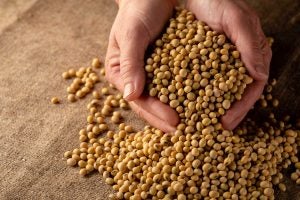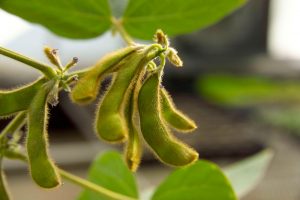The U.S. is the world leader in soybean production, with the soybean plant being grown on more than 90 million acres here each year
The great American landscape greens up each spring as millions of acres are planted with one of the most dynamic of Earth’s crops — the mighty soybean. One of America’s biggest cash crops, soybean production dominates a full third of the country while serving as a principle export. Growers have long been accustomed to rotating it into the seasonal mix of corn and wheat, but it’s important to know what all makes the soybean plant so special to America.
Most soybeans are processed for their oil in one way or another, with the average 60-pound bushel generating about 11 pounds of crude oil and 47 pounds of meal. But at about 38 percent protein relative to 18 percent oil, the opportunities for food are also as limitless as other industrial products. Producers hoping to maximize their markets would do well to brush up on some of these facts as they lobby for better prices by way of new products, as well as continued innovation in growing technologies which can slash costs.
Soybean facts
Before going into more detail about the soybean plant and its agricultural value, here are some general soybean facts:
- The soybean plant is a legume related to peas, clover and alfalfa
- It is used for human food, animal feed, biodiesel, and as a component in a host of other products
- In 2018, U.S. farmers grew 4.39 billion bushels of soybeans
- The average yield was 49.1 bushels per acre (a bushel of soybeans weighs 60 pounds)
- Randy Dowdy holds the world record for soybean yield at 190.23 bushels per acre using Hefty 49X7S
- A bushel of soybeans produces about 11 pounds of oil and 48 pounds of protein-rich meal
- Each soybean plant generally produces 60 to 80 pods, each holding three pea-sized beans
- Illinois is the nation’s top-producing soybean state

Soybean plants by the numbers
In 2018, the total value of the U.S. soybean crop was $41.01 billion, representing 4.39 billion bushels with an average yield of 49.1 bushels per acre. Once again, the U.S. was the world leader in soybean production, followed by the nation of Brazil with 4.15 billion bushels. A total of 90.1 million U.S. acres were dedicated to soybeans in 2017, representing about 34 percent of total crop area planted, with corn also coming in at 34 percent, wheat 17 percent, cotton 5 percent and sorghum 2 percent. This represents an upward trend in total soybean acres from 58.8 million in 1988 to 72 million in 1998, 75.7 million in 2008.
In terms of export value, 1988 saw 527 million bushels shipped overseas, compared to 805 million bushels in 1998, 1.279 billion in 2008 and 2.065 billion in 2017. China is America’s biggest buyer of soybeans at $12.356 billion worth, followed by Mexico at $1.586 billion, the Netherlands at $1.103 billion, and Japan at $976 million annually. About 82 percent of the soybeans exported are sold whole, with soybean meal representing 15 percent and soybean oil 3 percent of exports.
Unfortunately, prices haven’t exactly taken the same track. In 1988, soybeans averaged $7.42 per bushel, dropping down to $4.93 in 1998, up to $9.97 in 2008, and only $9.30 in 2017, all the while producers would note a rising cost in input variables across the board. Leading producers at the state level in 2017 included Illinois with 611.9 million bushels, Iowa with 561.6 million, Minnesota with 380.2 million, Nebraska 326 million, and Indiana with 320.8 million.

Multi-purpose agricultural crop
The soybean’s prolific production is related to its numerous uses, one of which is biodiesel. A fuel for diesel engines produced by transesterification, the production process involves the removal of glycerine from the oil. U.S. biodiesel production has been on the increase since 2 million gallons were generated in 2000, to 700 million gallons in 2008, and 1.83 billion gallons in 2017.
In terms of animal feed, 18.9 million short tons of U.S. soybeans went to feed poultry, with 8.6 million going to swine, 2.8 million for beef, 2.5 million for dairy, and 0.8 million for pet food.
Meanwhile, the industrial uses of soy oil continue to blossom by way of check-off dollars, with products as diverse as roofing and flooring materials as well as cleaning agents and resins. Soy ink, crayons and other building materials all claim a more environmentally friendly impact on the production cycle, while increasing demand for the producers’ yield.

Evolving strategies for growing soybeans
One of the reasons for the demonstrated growth in soybean production is the continued improvements in associated technologies. As a rule, soybeans should be planted when soil temperatures are around 50 degrees F, and this makes for tricky decisions when spring times are cool and damp as yields drop as many 8 to 10 bushels per acre when planted later into May or June. Meanwhile, some of the most crucial advancements in agriculture have come by way of seed genetics and the ability to hand-select traits. This comes into play as producers in different regions can choose later maturing hybrids as opposed to full-season, balancing higher yields against cost of production, as the per bushel price has remained relatively flat since the 1980s.
Soybean prices can be found directly on the Chicago Board of Trade website here, while a variety of vital Soybean Reports are available CBOT here.
There’s little question that soybeans will continue to be an integral part of the U.S. agricultural output for decades to come, with more uses yet to be discovered and better methods of growing and harvest.



